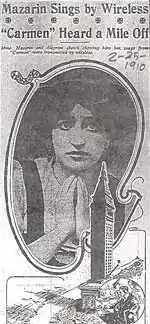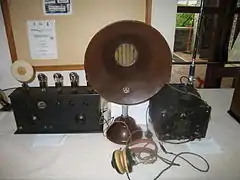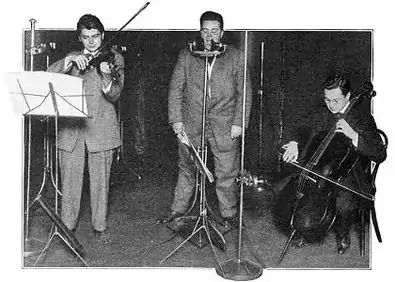Birth of public radio broadcasting
The birth of public radio broadcasting is credited to Lee de Forest who transmitted the world’s first public broadcast in New York City on January 13, 1910. This broadcast featured the voices of Enrico Caruso and other Metropolitan Opera stars. Members of the public and the press used earphones to listen to the broadcast in several locations throughout the city. This marked the beginning of what would become nearly universal wireless radio communication.

First public broadcast
Date
A 1907 advertisement placed by Lee de Forest's Radio Telephone Company stated:
It will soon be possible to distribute grand opera music from transmitters placed on the stage of the Metropolitan Opera House by a Radio Telephone station on the roof to almost any dwelling in Greater New York and vicinity ... The same applies to large cities. Church music, lectures, etc., can be spread abroad by the Radio Telephone.[1]
Several years later, on January 13, 1910, the first public radio broadcast was an experimental transmission of a live Metropolitan Opera House performance by several famous opera singers.[1] This transmission was arranged by de Forest.[2] This event is regarded as the birth of public radio broadcasting.[3]
Performers
The wireless radio broadcast consisted of performances of Cavalleria Rusticana and Pagliacci.[4] Riccardo Martin performed as Turridu, Emmy Destinn as Santuzza, and Enrico Caruso as Canio.[5][6] The conductor was Egisto Tango.[7]
The New York Times reported on January 14, 1910:
Opera broadcast in part from the stage of the New York City Metropolitan Opera Company was heard on January 13, 1910, when Enrico Caruso and Emmy Destinn sang arias from Cavalleria Rusticana and I Pagliacci, which were "trapped and magnified by the dictograph directly from the stage and borne by wireless Hertzian waves over the turbulent waters of the sea to transcontinental and coastwise ships and over the mountainous peaks and undulating valleys of the country." The microphone was connected by telephone wire to the laboratory of Dr. Lee de Forest.[8]
Equipment

The few radio receivers able to pick up this first-ever "outside broadcast" were those at the De Forest Radio Laboratory, on board ships in New York Harbor, in large hotels on Times Square and at New York City locations where members of the press were stationed at receiving sets.[1][9][10] Public receivers with earphones had been set up in several well-advertised locations throughout New York City. There were members of the press stationed at various receiving sets throughout the city and the public was invited to listen to the broadcast.[6]
The experiment was considered mostly unsuccessful.[5] The microphones of the day were of poor quality and could not pick up most of the singing on stage.[5] Only off-stage singers singing directly into a microphone could be heard clearly.[5] The New York Times reported the next day that static and interference "kept the homeless song waves from finding themselves".[6][11]
De Forest's Radio Telephone Company manufactured and sold the first commercial radios in the demonstration room at the Metropolitan Life Tower in New York City for this public event.[9] The wireless transmitter had 500 watts of power.[5] It is reported that this broadcast was heard 12.5 miles (20.1 km) away on a ship at sea.[12] The broadcast was also heard 60 miles (97 km) away in Bridgeport, Connecticut.[13]
Significance

The birth of public radio broadcasting had an immediate impact on radio broadcasting as it stimulated the idea of having additional musical programs. The next month on February 24th the Manhattan Opera Company's new opera singer Mariette Mazarin sang "Love is a rebellious bird" from Carmen over a transmitter located in DeForest's laboratory.[14] This radio concert was heard by a group of scientists, diplomats, newspaper reporters and the public within 20 miles (32 km).[15]
The New Jersey Telephone Herald did evening musical shows after their regular daily newscasts starting on March 15, 1911. The various musical programs consisted of instrumental music from a regular orchestra in attendance, individual recitals, and group singers.[16] In addition they had theatrical performances, opera and organ playing at their new location on the second floor of the Essex Building in Newark, New Jersey.[17]
DeForest in 1912 put together an amplifying technology from his 1906 Audion vacuum tube invention. He figured out how to take a weak signal and increase it many times (amplification) through a feedback circuit. He had learned through experimentation that his Audion would increase the strength of a weak signal to some degree if a small wire mesh was placed inside the vacuum tube between the heated electron emitting element at the bottom of the tube and the pick up plate on top that had a high voltage opposite charge. He took this electronic idea one step further by taking part of that amplified electrical signal and sending it back through the Audion again. That increased the signal strength even further. That idea was further developed by Edwin Armstrong and Alexander Meissner and the technology of the vacuum tube feedback oscillator was perfected in 1912 by them.[18]
This continuous feedback loop idea became a source of continuous waves through repeated feedback and amplification over and over again. The continuous waves of a particular frequency could be altered to a small degree by another signal introduced into it. This is called amplitude modulation. This was further advanced to the idea of having very high frequency continuous waves (tens-of-thousands of cycles-per-second (kHz) modulated (slightly altered) with another signal (e.g. voice, music) from a microphone. From that concept developed the amplitude modulated transmitter, which lead to AM radio broadcast entertainment.[19][20]
See also
References
Citations
- "Lee De Forest history". Archived from the original on June 10, 2008. Retrieved June 24, 2008.
- Chase 2000, p. 84.
- "People and Discoveries". Retrieved June 24, 2008.
- "Opera by Wireless". The Spokesman Review. Spokane, Washington. April 17, 1910. p. 17 – via Newspapers.com.

- "Cavalleria Rusticana and I Pagliacci". Retrieved June 24, 2008.
- Fantel, Hans (January 14, 1990). "Sound; Out of De Forest and onto the air came music". The New York Times. Retrieved June 24, 2008.
- "The New York Tribune, January 13, 1910, p.14, "Amusements" listings". Retrieved May 1, 2011.
- Kane 1981, p. 442.
- "Adventures in Cybersound". Archived from the original on July 5, 2008. Retrieved June 24, 2008.
- Whiteley, Sandy (October 14, 2002). On This Date: A Day-by-Day Listing of Holidays, Birthdays, and Historic, by Sandy Whiteley, p. 13. ISBN 9780071398275. Retrieved June 24, 2008.
- "Wireless Melody Jarred," The New York Times, Friday, January 14, 1910, page 2
- "1901–1910: Radio's Big Beginning". Archived from the original on August 10, 2006. Retrieved June 24, 2008.
- "Taking the Crucial Step for Modern Technology". Archived from the original on April 30, 2008. Retrieved June 24, 2008.
- "Radio Telephone Experiments", Modern Electrics, May 1910, page 63. (earlyradiohistory.us)
- "1910 Opera Star Recalls First Radio Concert". The Daily News. Huntingdon, Pennsylvania. December 30, 1946. p. 10 – via Newspapers.com.

- Arthur F. Colton 1911, p. 666.
- "New Service on March 15". Perth Amboy Evening News. Perth Amboy, New Jersey. February 16, 1911. p. 3 – via Newspapers.com.

- DeForest Radio Co. v. General Electric Co., 283 U.S. 664 (May 25, 1931).
- Aitken 1985, p. 61.
- "Radio Transmission / The Early Years of Radio". Retrieved April 13, 2020.
Sources
- Aitken, Hugh G.J. (1985). The Continuous Wave. Princeton University Press. ISBN 0691083762.
- Chase (2000). Chase's 2000 Calendar of Events. Contemporary Publishing Group. ISBN 0-8092-2776-2.
- Kane, Joseph Nathan (1981). Famous First Fact. The H.W. Wilson Company. ISBN 0-8242-0661-4.
- Arthur F. Colton (1911). "Telephone Newspaper - A New Marvel". The Technical World Magazine. New York City: Technical World Company. Retrieved April 9, 2020.